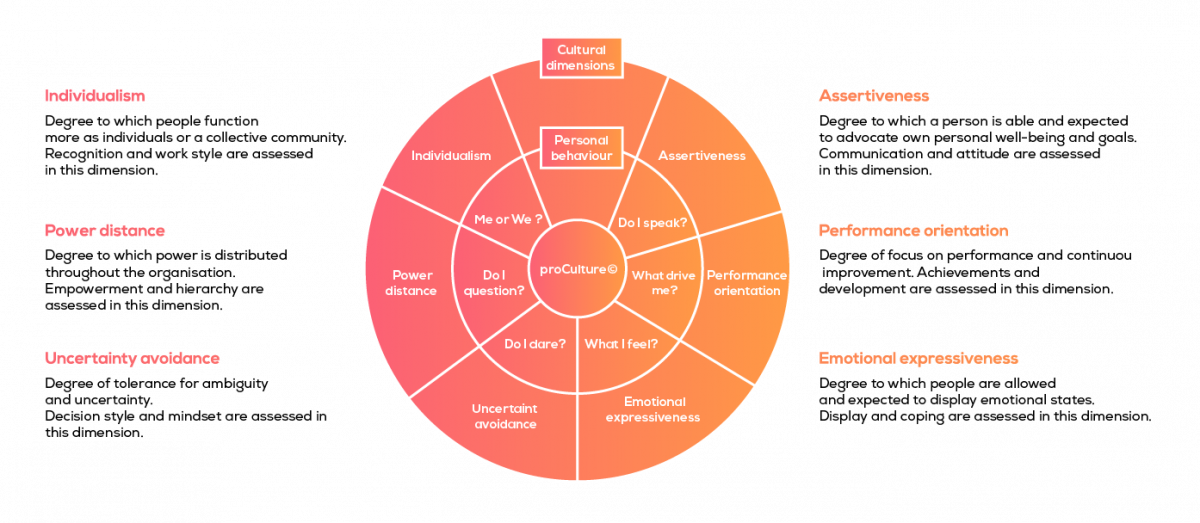Culture. As a leader, it should be top of your mind now more than ever. Culture will largely determine your ability to “re-emerge or restart” business after Covid-19. How agile, innovative and productive your organisation will be in the new work environment post-Covid-19 is almost exclusively determined by your organisational culture. But to manage it, you need to measure it. The bad news? Culture is a strange beast, elusive and difficult to label. The good news? proCulture® is there to help. If you wish to understand and pivot your culture, look no further.
Organisational culture matters more than ever
Culture, a classic component of change success. First, let’s look at the evidence. Research conducted by McKinsey shows that 70% of project failures “are due to culture-related issues”. Not for nothing is cultural awareness considered as “either important or very important to a change initiative” by 90% of the participants to PROSCI’s Best Practices in Change Management. Culture determines leadership style, impacts employee’s engagement, customer satisfaction, how innovative your organisation can be, and ultimately, its performance. And today’s crisis is challenging all these parameters. A real effort to understand your organisation’s culture is therefore needed in Covid-19.
Your culture will determine your ability to adapt faster and better in Covid-19. Covid-19 has disrupted our working routines at a speed and scale never seen before. What worked well in a traditional office setting is now facing a difficult test with the transition to remote working. How well an organisation can support productivity and engagement in a virtual workplace is a matter of culture. Does your environment promote autonomy, initiative, collaboration, and empathy? For instance, are your employees empowered to speak up, take decisions and challenge the status quo? Or do they trust the top management to steer the boat? If the figure of “lone leaders” is familiar to you, then you might have already experienced first-hand the slowing down of decision-making processes in a hybrid environment. Disengagement and a wait-and-see attitude among collaborators may have stifled innovation, and with it, the capacity to reinvent working processes. Bottom-line: the organisational culture can threaten to wreak havoc on an otherwise healthy business. Either way now is the time to take a hard look at your culture as a change enabler… or blocker.
Name it to tame it
Culture: what’s in a word. To put it simply, organisational culture is the common set of behaviours and underlying beliefs that shape the way we interact and work. But just like an iceberg, there is a visible and a submerged part. Because if we are quite aware of our actions and core values, the system that underpins them operates subconsciously. Enter the hidden maze of culture: unspoken norms, processes, market position, products, language, history, management style, etc…. So the obvious question is: how do you capture what goes unseen?
Measure it, change it. Fret not. That is a difficult, but not impossible task. Culture can be mapped out. And while not perfect, the results can get you close. Beware, though, that this is not a “managerial task” in essence. To avoid biases, think of cultural mapping as a structured attempt at collecting relevant data across the whole workforce spectrum. Here is a quick introduction to proCulture®, a powerful and holistic tool for assessing cultural traits. If culture can be measured and tracked, it means that it can be managed … thus changed.

proCulture®, the tool you need to map out your organisational culture
6 dimensions, 12 sub-categories, 36 aspects. Take a quick look at the figure above. Culture is broken down into six dimensions: assertiveness, performance orientation, emotional expressiveness, uncertainty avoidance, power distance and individualism. Each dimension is in turn divided into 2 sub-categories, each containing 3 aspects. This 360-degree perspective allows you to map your culture, shedding light on the way things get done in your organisation. Interviews and focus groups are key to kick-start the exploration and generate qualitative data. In a nutshell, collaborators are expected to rate each aspect of the culture they work in on a scale from extremely low to extremely high. Registering the specific challenges that support these views provides in-depth insights into the strengths and weaknesses of the organisational culture. Check out our full report for a step-by-step explanation of the methodology.
No cultural traits are better than others, but some of them are worth investigating in Covid-19. Of course, low tolerance for uncertainty and ambiguity (uncertainty avoidance) in the current context is a direct and urgent call for better change management. But other traits, starting with power distance – the degree of access to high-level members –, are well worth paying attention to. A democratic and proactive culture where people voice their opinions can give organisations an edge. Mobilising collective intelligence – and driving engagement, for that matter – is critical in Covid-19. Two equally significant dimensions are emotional expressiveness and assertiveness. Much has been written on the importance for people to be able to open up in an attempt to promote resilience and facilitate resistance management. Empathy is pretty much a buzzword those days, for good reasons.
Once you have the big picture, what’s next? Changing the culture is not an overnight process. You will have to get some critical things right to start the journey. Picking up a few key values and aligning strategy with culture is just a starting point. Remember that there is no change without excellent sponsorship, no change without leaders walking the talk, and no sense of progress of without an efficient monitoring system.
Article written by Morten Kamp Andersen
